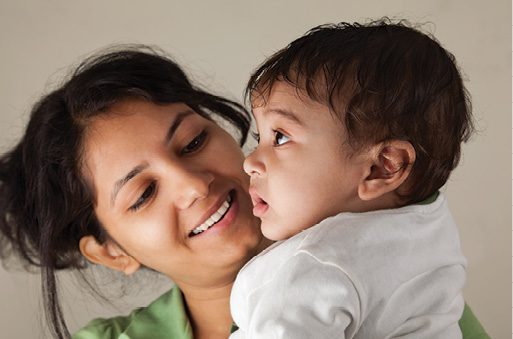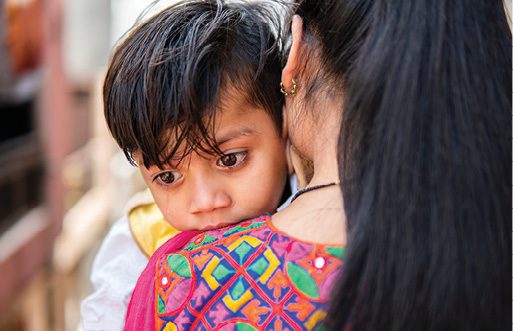Sufna John, University of Arkansas for Medical Sciences
Editor’s Note
The following article is excerpted and adapted from the forthcoming DC:0–5 Casebook (Mulrooney et al., in press). The Casebook is a compilation of case studies as a companion volume to DC:0–5TM: Diagnostic Classification of Mental Health and Developmental Disorders of Infancy and Early Childhood (DC:0–5; ZERO TO THREE, 2016, 2021). The casebook is designed to strengthen understanding of clinical disorders in infancy and early childhood, and to help clinicians better understand the application of the multiaxial framework and culturally sensitive/relational approach to diagnosis that is fundamental to DC:0–5.
Children develop within the context of caregiver–child relationships, each presenting with their own unique strengths, areas of growth, and compatibility of fit. Instead of the traditional viewpoint that child symptoms are generalizable across contexts and would emerge across relationships, the DC:0–5TM: Diagnostic Classification of Mental Health and Developmental Disorders of Infancy and Early ChildhoodTM (DC:0–5; ZERO TO THREE, 2016, 2021) manual provides the ability to capture emotional or behavioral challenges that only exist within the context of one relationship. A diagnosis of relationship-specific disorder of infancy/early childhood does not specify the nature of evident emotional or behavioral difficulties; instead, it could encompass a variety of emotional, behavioral, or social challenges that solely present in one relationship. If a child is demonstrating these challenges in other relationships, this diagnosis should not be given. Moreover, the diagnosis does not presume the cause of symptoms, acknowledging that there may be caregiver, child, environmental, or relational factors that have contributed to symptom presentation. This case exemplifies how this disorder was diagnosed in a case of a mother–child relationship for a 50-month-old boy.
Identifying Information/Reason for Referral
Arjun Singh (not actual name) is a 50-month-old boy, the only child of his mother, Lakshmi Singh (37 years old), and father, Rishi Singh (42 years old), who both immigrated to the United States from India. Arjun was born in the United States, identifies as Hindu, and speaks both English and Hindi. He was brought to the clinic by his mother and father who explain that he refuses to sleep in his own bed, is very clingy with his mother, is noncompliant with his mother’s directives, and has been crying and screaming when his mother drops him off at his early childhood education (ECE) program. No concerns were noted by his teachers beyond the initial drop-off distress. Lakshmi identifies as Hindu. She immigrated to the United States in her early 20s and speaks both English and Hindi. Rishi also identifies as Hindu. He immigrated with his wife to the United States in his mid 20s and speaks both English and Hindi.
History of Presenting Concerns/ Relevant History
Arjun was born full-term, at 39 weeks gestation, via vaginal delivery. No complications during pregnancy or birth were noted, and both Arjun and Lakshmi spent 2 days in the hospital post-delivery. Lakshmi denied the use of substances during pregnancy and indicated that she had frequent prenatal appointments because of a history of miscarriage. Arjun was Lakshmi’s third pregnancy (she suffered two first-trimester miscarriages before becoming pregnant with Arjun).
Medical history for Arjun indicates the presence of chronic ear infections between 9 and 14 months old, at which point he underwent surgery to place pressure equalizer tubes in both ears. Lakshmi reported this procedure significantly helped. Other than ear infections, Lakshmi reported that Arjun is a healthy, active boy. Lakshmi reported that Arjun met all of his motor milestones on time. She denied any concerns related to speech development, and the clinician observed Arjun to speak and move fluently during the intake. She stated that his ECE teachers describe him as bright and curious, with no learning, behavioral, emotional, or social difficulties in the classroom noted.
Lakshmi reported that Arjun has always been a difficult baby to soothe, recounting the need to walk and rock him to sleep multiple times per night as an infant. As a toddler, she reported frequent waking in the middle of the night and that he would return to sleep only if she held him. She reported that these challenges with sleep and soothing were difficult on her marriage because her husband worked early hours and the disruptions in sleep were difficult. Therefore, Lakshmi began sleeping in Arjun’s room when he turned 2 years old. She reported that she has tried to transition back into her own bedroom in the last 6 months, but she is unable to do so without Arjun crying, screaming, and clinging to her body. If she remains in his room, he sleeps through the night. In general, Lakshmi reported persistent “coddling” of Arjun, elaborating that she had wanted children so badly and did not want Arjun to “suffer at all” with her. Rishi agreed that Lakshmi is “too passive” with Arjun at times and attributed this permissiveness to Lakshmi’s deep love for him and the grief she felt during miscarriage.
Lakshmi noted that she has taken one trip away from Arjun 3 months ago, when her sister passed away in India and she returned for the funeral ceremonies. She was gone for 16 days and would speak to Arjun by video call each morning. She was surprised to learn that, during her trip, Arjun was sleeping in his own bedroom without his father’s presence and was showing minimal tearfulness at school drop-off. She reported feeling hopeful that this behavior would continue when she returned. However, she reported that Arjun’s behavior remained similar with her when she returned, with continued clinginess, fussiness, and refusal to sleep without her. She and Rishi both agreed that Arjun treats his mother very differently than his father. Rishi reported that Arjun is more independent in their relationship and denied challenges with separation distress or noncompliance.
Cultural Context and Formulation
Rishi and Lakshmi were both born and raised in Mumbai, India. Their parents were acquaintances through work, which led to them meeting one another when Lakshmi was 20 years old and Rishi was 25 years old. Both report that they got along well with one another and realized that they shared many values. They were married the year they met and immigrated to the southern United States together because of a job opportunity for Rishi in chemical engineering. Both reported overall satisfaction with living in the United States, noting that they perceived greater opportunities for their son in the United States compared with India. Lakshmi reported missing the “community” in India, noting that there are relatively few Indians in her area and that she has met only a handful of other parents of Arjun’s peers, none of whom are Indian. Rishi elaborated that they have felt like “outsiders” at times since moving to the United States, and he and his wife described several examples of microaggressions that they have experienced since immigrating (e.g., parents of other children assuming they do not speak English because of their skin color and names, families being uncertain about evening play dates because they do not believe their child would like the Indian food Lakshmi prepares).

Children develop within the context of caregiver–child relationships, each presenting with their own unique strengths, areas of growth, and compatibility of fit. Photo: Shutterstock/ELAKSHI CREATIVE BUSINESS
Lakshmi reported feeling lonely and isolated at times, particularly when Rishi has busy times at work and is away for most of the day. Rishi reported strong social support at work and satisfaction with his job. Both reported a religious upbringing and continued identification with Hinduism, stating their spirituality as a core area of strength and coping. They both reported clear gender role expectations within their culture and stated that they are the “typical Indian family,” in which Rishi works outside of the home and is responsible for the financial resources of their family, and Lakshmi works within the home and takes primary caregiving responsibilities over Arjun. Both reported satisfaction with roles and responsibilities in their marriage and parenting. They stated that they predominantly speak Hindi at home with one another and with Arjun and use English outside of the home. All mental health services were conducted in English.
Clinical Observations
Arjun participated in a Crowell relationship observation (Crowell et al., 1988; Sprang & Craig, 2014) separately with each of his parents. The clinician used the “What to Look for in Relationships” handout (Osofsky et al., 2016) to organize observations. Within the mother–child dyad, the clinician noted strengths in mutual positive engagement and teaching/ scaffolding. The clinician noticed frequent instances of non-compliance during free play and teaching tasks and reported high levels of verbal intrusion from Lakshmi. Arjun expressed strong distress when separated from his mother during the observation, including calling out for her, crying, and banging his fists on the table. After they were reunited, he repeatedly asked his mother where she went and told her not to leave again. The two proceeded to return to collaborative play.

A diagnosis of relationship-specific disorder of infancy/early childhood encompass a variety of emotional, behavioral, or social challenges that are solely present in one relationship. Photo: Shutterstock/Clovera
Within the Crowell relationship observation with Rishi, the clinician noted strengths in developmentally appropriate play, child compliance with parent directives, and mutual positive engagement. The clinician noted Rishi to use a firm, sometimes harsh, tone of voice with Arjun when giving directives. Within the separation, Arjun cried quietly for the first minute and then began playing with the puppets that he and his father had enjoyed during free play. After they were reunited, Arjun approached Rishi, showed him the puppets, and the two began playing together again.
Within early sessions, the clinician noted Rishi and Lakshmi to have a warm relationship with one another. Rishi reported feeling empathy for Lakshmi and frustrated that Arjun behaves worse with her. Lakshmi frequently expanded on statements that Rishi made in session, and the two appeared to agree on most things. Lakshmi expressed confusion as to why Arjun was so clingy with her and reported feeling guilty that she had coddled him too much during infancy, which she attributed as a primary reason for his current clingy behavior with her. Both reported their marriage to be strong and noted that it grew in strength after coping with both of their miscarriages. The clinician noted that, when all three were in the room, Arjun oriented more toward his father (who predominantly set limits). When Rishi was not in the room, the clinician noted that Arjun oriented to his mother but was less compliant with her limits. The clinician noted Arjun to be a vocal, active child who frequently sought affection from both his parents. He was quickly acclimated to the therapy office and the clinician, asking her questions and complying with her limits surrounding the rules in her office. Both parents reported being unsurprised with Arjun’s positive behavior and compliance with the clinician, stating that his teachers report similar behavior in the classroom.
Assessment Measures
In addition to the Crowell relationship observation, the clinician administered the Ages and Stages Questionnaire, Third Edition (ASQ–3; Squires & Bricker, 2009) and the Ages and Stages Questionnaire: Social–Emotional, Second Edition (ASQ:SE–2; Squires et al., 2015) to screen for development. The clinician also administered the Child Behavior Checklist for Ages 1.5–5 (CBCL/1.5–5; Achenbach & Rescorla, 2000) to gauge emotional and behavioral difficulties. The parents completed the ASQ–3 and ASQ:SE–2 together, and each independently filled out the CBCL/1.5–5. Results from the ASQ–3 and ASQ:SE–2 indicated normative development across domains, with no areas of concern noted. Rishi’s CBCL/1.5–5 noted clinical elevations in emotional reactivity. Lakshmi’s CBCL/1.5–5 noted clinical elevations in emotional reactivity, anxious depression, and aggressive behavior. Lakshmi reported overall internalizing problems in the clinical range. Results on these scales indicated anxiety problems in the clinical range for both parents and oppositional defiant problems in the clinical range within his mother’s report.
Case Conceptualizations/Differential Diagnosis Considerations
Arjun presents with several symptoms of separation anxiety; thus, separation anxiety disorder was considered. These symptoms included recurrent, excessive distress when separating from his mother; persistent reluctance to go to child care, which manifests as crying and tantrums to avoid separation at drop-off; and persistent refusal to sleep without the presence of his mother. Arjun did not evidence these problems when brought to the ECE center by his father, and he did not have sleep refusal problems at school or with father; these problems emerged only in the context of his relationship with his mother. These symptoms cause significant distress to the child and caregiver. However, these symptoms exclusively manifest within the relationship with his mother; thus, they are best described within a relationship-specific disorder of infancy/ early childhood.
Similarly, Arjun presents with some behavioral dysregulation; thus, disorder of dysregulated anger and aggression of early childhood was considered. Indeed, Arjun actively defies his mother, has difficulty calming down when angry, and frequently breaks rules with his mother watching. These challenges reportedly happen daily and cause distress to his family. However, similar to separation distress, these behavioral and emotion regulation challenges manifest exclusively within the relationship with his mother; thus, these symptoms are best characterized within his relationship-specific disorder of infancy/early childhood. Of note, this disorder does not presume the etiology of their current difficulties, and it is not meant to place blame on either member of the dyad. Instead, the clinician used information gathered through observation and assessments to explore the various factors that could be contributing to these challenges.

The clinician working with this family should take care to understand their own social location and how their identities and values interact with those of the family. Photo: Shutterstock/fizkes
First, the clinician noted dimensions of Arjun’s temperament that were clear at a young age (e.g., poor soothability), which may have contributed to the current difficulties. The clinician also noted that Lakshmi’s permissive and “clingy” parenting stance—which may have been influenced by her history of miscarriages and the strategies she had to use for sleep in his toddler years—could have contributed to these symptoms. Indeed, Lakshmi described a strong desire to avoid Arjun’s distress because she wanted children so badly after her losses. Moreover, the relationship between Arjun and Lakshmi involved navigating daily life situations (child care drop-off, primary caregiving, and associated rituals/routines) that Arjun rarely navigates with his father because of Rishi’s work schedule. Finally, the cultural role distribution between Lakshmi and Rishi also creates a different caregiving environment for Arjun with each of his parents.
Diagnostic Summary
The DC:0–5 multiaxial framework consists of: clinical disorders (Axis I), relational context (Axis II), physical health and considerations (Axis III), psychosocial stressors (Axis IV), and developmental competence (Axis V).
Axis I
Arjun’s symptoms fit the diagnostic algorithm for relationship-specific disorder of infancy/early childhood (with symptoms of noncompliance, emotion dysregulation, and separation distress with his mother).
Axis II
Caregiving Dimension: Mother–Child: Level 3 (Compromised to Disturbed Relationship). Concerns related to separation distress, emotion dysregulation, and defiance appear predominantly in Arjun’s relationship with his mother, and she reports persistent distress in caregiving. The dyad’s capacity to regulate emotions and promote age-appropriate autonomy is underdeveloped and causes impairment.
Caregiving Dimension: Father–Child: Level 1 (Well-Adapted Relationship to Good Enough). No significant concerns were noted with Arjun’s relationship with his father.
Caregiving Environment: Level 2 (Strained to Concerning). Despite significant differences in the quality of relationship between Arjun and each caregiver, there are notable adaptive qualities of the caregiving environment, in which both parents report their relationship to feel strong, collaborative, and mutually satisfying. However, there is also evidence of misalignment of caregiver expectations, caregiver response to Arjun’s need for comfort and soothing, and engagement in mutually positive play interactions.
Axis III
Arjun had chronic ear infections in his infancy/toddler years, resulting in bilateral pressure equalizer tubes. This procedure sufficiently controlled the condition, and no current concerns are noted.
Axis IV
The parents had two prior miscarriages before the birth of Arjun, and they have also been exposed to microaggressive encounters related to race, language, and cultural values. The family reports limited social support in the area, noting that most close relationships are with relatives or friends who are still in India or who have immigrated to different states.
Axis V
All domains are within the fully present range, apart from emotional and social–relational functioning, which are reported as inconsistently present or emerging because of regulation challenges in the relationship with Arjun’s mother.
Discussion
Arjun is a 50-month-old, Indian boy who demonstrates difficulties with separation distress and noncompliance in his relationship with his mother, Lakshmi. These difficulties are noted to cause impairment in the mother–child relationship and persistent caregiving distress. Of note, these difficulties do not appear to manifest within Arjun’s relationships with his father or teachers; in addition, the clinician also noted the lack of these symptoms within her interactions with Arjun. Moreover, the symptoms largely reduced when his mother was out of the country for a trip recently and reemerged when she returned home. Arjun is diagnosed with a relationship-specific disorder of infancy/early childhood to sufficiently capture the range of behavioral and emotional symptoms he demonstrates exclusively within his relationship with his mother.
The family noted several cultural factors that are important to consider within case conceptualization and treatment. Specifically, the family reports that their immigration experience to the United States from India elicited both positive
and negative experiences for them. Within this, they shared frequent microaggressions they have experienced and how
this has led them to feel isolated from others. The clinician should explore these microaggressions with the family, including how they have negatively impacted the family growing a local support system. They are a bilingual family who primarily speaks English within therapy sessions, although they sometimes speak Hindi to one another in front of the therapist or within the waiting room. They reported satisfaction with clearly defined family roles related to gender and identified their Hindu faith as central to their coping and values.
The clinician working with this family should take care to understand their own social location and how their identities and values interact with those of the family. Indeed, the clinician may hold membership within groups who have committed microaggressions against the family. This interaction between cultural groups, in combination with the power differential inherent in the therapist–family relationship, could hinder treatment if it is not considered. It is important for the clinician to approach this family with a culturally humble stance that centers the family’s culture and beliefs to resolve Arjun’s relationship-specific disorder of infancy/early childhood with his mother. There may also be temptation for the clinician to place blame or responsibility on one member of the dyad for these difficulties, which may be even more exacerbated because of the history of mental health clinicians placing unbalanced blame on mothers for child difficulties. The clinician should have routine access to reflective supervision that would focus on the content of sessions and the process behind the clinician’s feelings, values, and behaviors.
For Your Consideration
- How can you embrace the Diversity-Informed Tenets for Work With Infants, Children, and Families (Ghosh Ippen et al., 2012; Irving Harris Foundation, 2012) to provide culturally humble care?
- How might you explain the presence of a relationship-specific disorder to Lakshmi, Rishi, and Arjun in a supportive, nonjudgmental manner?
- What therapeutic interventions would you consider for this family, and who would be involved in services?
- What strengths do you note in this child and family that you can use within the intervention?
Learn More
The DC:0–5 Casebook will be published by ZERO TO THREE in early 2023 and available online at www.zerotothree.org/bookstore.
To learn more about the DC:0–5TM: Diagnostic Classification of Mental Health and Developmental Disorders of Infancy and Early Childhood (2016/2021) manual and training resources, visit www.zerotothree.org/dc:0-5
Author
Sufna John, PhD, is a licensed psychologist and associate professor in the Department of Psychiatry at the University of Arkansas for Medical Sciences. She directs several programs that focus on improving outcomes for children and families across the state of Arkansas who have experienced trauma. Dr. John is also a DC:0–5 and child-parent psychotherapy state trainer. She is passionate about partnering with the various systems that serve youth and families (e.g., child welfare, schools, mental health agencies) to promote trauma-informed and equitable practices for children and caregivers.
Suggested Citaiton
John, S. (2022). Concerns within a caregiver–child relationship: The diagnosis of a relationship-specific disorder of infancy/early childhood. ZERO TO THREE Journal, 43(2), 20–24.
References
Achenbach, T., & Rescorla, L. (2000). Child Behavior Checklist for Ages 1.5–5. University of Vermont, Research Center for Children, Youth, & Families.
Crowell, J., Feldman, S., & Ginsberg, N. (1988). Assessment of mother–child interaction in preschoolers with behavior problems. Journal of the American Academy of Child and Adolescent Psychiatry, 27, 303–311.
Ghosh Ippen, C., Noroña, C. R., & Thomas, K. (2012). From tenet to practice: Putting diversity-informed services into action. ZERO TO THREE Journal, 33(2), 23–28.
Irving Harris Foundation. (2012). The Diversity-Informed Tenets for Work With Infants, Children, and Families. https://diversityinformedtenets.org
Mulrooney, K., Keren, M., & Osofsky, J. D. (Eds.). (in press). DC:0–5TM casebook: A guide to the use of “DC:0–5TM: Diagnostic classification of mental health and developmental disorders of infancy and early childhood” in diagnostic assessment and treatment planning. ZERO TO THREE.
Osofsky, J. D., Hansel, T. C., Kronenberg, M., & Graham, R. (2016). What to look for in relationships. Louisiana State University Health Sciences Center.
Sprang, G., & Craig, C. (2014). Crowell problem solving procedure: A psychometric analysis of a laboratory measure of the caregiver–child relationship. Child and Adolescent Mental Health, 20, 202–209.
Squires, J., & Bricker, D. (2009). Ages and Stages Questionnaires®, Third Edition (ASQ–3): A parent-completed child monitoring system. Brookes.
Squires, J., Bricker, D., & Twombly, E. (2015). Ages and Stages Questionnaires®: Social–Emotional, Second Edition (ASQ:SE–2): A parent-completed child monitoring system for social–emotional behaviors. Brookes.
ZERO TO THREE. (2016). DC:0–5TM: Diagnostic classification of mental health and developmental disorders of infancy and early childhood.
ZERO TO THREE. (2021). DC:0–5TM: Diagnostic classification of mental health and developmental disorders of infancy and early childhood (Version 2.0).


